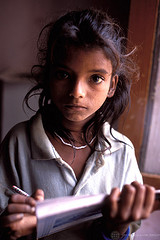
|
| A new UNICEF report casts spotlight on the plight of children in cities Photo: John Isaac/World Bank |
By Mark Tran
[28 Febuary 2012] -- Unicef has urged governments to put children at the heart of urban planning – and to improve services for all – since the majority of the world's children will grow up in towns or cities rather than in rural areas.
In its report, The State of the World's Children 2012: Children in an Urban World, the UN agency said hundreds of millions of children who live in urban slums are being excluded from vital services, from clean water to education.
"When many of us think of the world's poorest children, the image that comes readily to mind is that of a child going hungry in a remote rural community in sub-Saharan Africa," said Anthony Lake, Unicef executive director.
"But millions of children in cities and towns all over the world are also at risk of being left behind. Excluding these children in slums not only robs them of the chance to reach their full potential; it robs their societies of the economic benefits of having a well-educated, healthy urban population."
By 2050, 70% of all people will live in urban areas. Already, one city dweller in three lives in slum conditions, lacking security of tenure in overcrowded, unhygienic places characterised by unemployment, pollution, traffic, crime, high living costs, poor services and competition over resources. In Africa, the proportion is six in 10.
Migration from the countryside has long driven urban growth and remains a major factor in some regions. But the last comprehensive estimate, in 1998, suggests that children born into existing populations account for around 60% of urban growth. The report acknowledges that urban areas offer greater potential to secure children's rights and accelerate progress towards the millennium development goals, because the more urban a country, the more likely it is to have higher incomes and stronger institutions.
Read the full story on The Guardian's website




